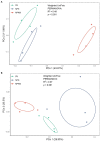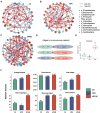Long-Term Organic-Inorganic Fertilization Regimes Alter Bacterial and Fungal Communities and Rice Yields in Paddy Soil
- PMID: 35832816
- PMCID: PMC9271892
- DOI: 10.3389/fmicb.2022.890712
Long-Term Organic-Inorganic Fertilization Regimes Alter Bacterial and Fungal Communities and Rice Yields in Paddy Soil
Abstract
Microorganisms are the most abundant and diverse organisms in soils and have important effects on soil fertility. In this study, effects of the long-term fertilization treatments no fertilizer (CK), chemical fertilizer (nitrogen-phosphorus-potassium (NPK)), and organic-inorganic fertilizer (NPK and organic fertilizer (NPKM)) on rice yield and soil bacterial and fungal community diversity, structure, composition, and interaction networks were evaluated. Of the three treatments, the highest rice yield was in NPKM. Bacterial richness was significantly higher in NPKM than in NPK. Fertilization treatment significantly altered β diversity of communities, species composition of bacterial and fungal communities, and structure of soil microbial networks. The most complex bacterial and fungal interaction co-occurrence network with the highest average degree and numbers of edges and nodes was in NPKM. Relative abundance of the plant growth-promoting fungus Trichoderma increased significantly in NPKM compared with CK and NPK. The results of the study indicate that bacterial richness and microbial community member interactions (network complexity) might be suitable indicators of soil biological fertility. This research provides new insights on the effects of different fertilization regimes on responses of soil bacterial and fungal communities and their contributions to crop yield. New indicators such as bacterial richness and complexity of microbial interaction networks are also identified that can be used to evaluate soil biological fertility.
Keywords: co-occurrence network; fertilization regimes; microbial community; rice; soil biological fertility.
Copyright © 2022 Ma, He, Chen, Li, Huang, Xue and Shen.
Conflict of interest statement
The authors declare that the research was conducted in the absence of any commercial or financial relationships that could be construed as a potential conflict of interest.
Figures







Similar articles
-
[Responses of fungal community structure and functional group to fertilization in yellow clayey soil.].Ying Yong Sheng Tai Xue Bao. 2018 Aug;29(8):2721-2729. doi: 10.13287/j.1001-9332.201808.003. Ying Yong Sheng Tai Xue Bao. 2018. PMID: 30182613 Chinese.
-
Soil carbon (C), nitrogen (N) and phosphorus (P) stoichiometry drives phosphorus lability in paddy soil under long-term fertilization: A fractionation and path analysis study.PLoS One. 2019 Jun 24;14(6):e0218195. doi: 10.1371/journal.pone.0218195. eCollection 2019. PLoS One. 2019. PMID: 31233510 Free PMC article.
-
DNA Stable-Isotope Probing Delineates Carbon Flows from Rice Residues into Soil Microbial Communities Depending on Fertilization.Appl Environ Microbiol. 2020 Mar 18;86(7):e02151-19. doi: 10.1128/AEM.02151-19. Print 2020 Mar 18. Appl Environ Microbiol. 2020. PMID: 31953339 Free PMC article.
-
Balanced fertilization over four decades has sustained soil microbial communities and improved soil fertility and rice productivity in red paddy soil.Sci Total Environ. 2021 Nov 1;793:148664. doi: 10.1016/j.scitotenv.2021.148664. Epub 2021 Jun 24. Sci Total Environ. 2021. PMID: 34328991
-
From diversity to complexity: Microbial networks in soils.Soil Biol Biochem. 2022 Jun;169:108604. doi: 10.1016/j.soilbio.2022.108604. Soil Biol Biochem. 2022. PMID: 35712047 Free PMC article. Review.
Cited by
-
Effects of nitrogen fertilizer basal-to-top-dressing ratios on maize straw decomposition, soil carbon and nitrogen, and bacterial community structure in different soil textures on the north china plain.Front Microbiol. 2025 Feb 5;16:1506155. doi: 10.3389/fmicb.2025.1506155. eCollection 2025. Front Microbiol. 2025. PMID: 39973933 Free PMC article.
-
Effects of Short-Term Straw Return and Manure Fertilization on Soil Microorganisms and Soybean Yield in Parent Material of Degraded Black Soil in Northeast China.Microorganisms. 2025 May 15;13(5):1137. doi: 10.3390/microorganisms13051137. Microorganisms. 2025. PMID: 40431309 Free PMC article.
-
Different responses of soil bacterial community to plant-plant interactions under organic-inorganic fertilizers affect seedling establishment during subalpine forest succession.Front Microbiol. 2024 Oct 1;15:1466668. doi: 10.3389/fmicb.2024.1466668. eCollection 2024. Front Microbiol. 2024. PMID: 39411428 Free PMC article.
-
Microbial fertilizers modulate tobacco growth and development through reshaping soil microbiome and metabolome.Microbiol Spectr. 2025 Jul;13(7):e0260524. doi: 10.1128/spectrum.02605-24. Epub 2025 May 22. Microbiol Spectr. 2025. PMID: 40401958 Free PMC article.
-
Different microbial communities in paddy soils under organic and nonorganic farming.Braz J Microbiol. 2024 Mar;55(1):777-788. doi: 10.1007/s42770-023-01218-5. Epub 2023 Dec 26. Braz J Microbiol. 2024. PMID: 38147271 Free PMC article.
References
-
- Allison S. D., Hanson C. A., Treseder K. K. (2007). Nitrogen fertilization reduces diversity and alters community structure of active fungi in boreal ecosystems. Soil Biol. Biochem. 39, 1878–1887. doi: 10.1016/j.soilbio.2007.02.001 - DOI
-
- Bending G. D., Turner M. K., Rayns F., Marx M.-C., Wood M. (2004). Microbial and biochemical soil quality indicators and their potential for differentiating areas under contrasting agricultural management regimes. Soil Biol. Biochem. 36, 1785–1792. doi: 10.1016/j.soilbio.2004.04.035 - DOI
LinkOut - more resources
Full Text Sources
Research Materials

